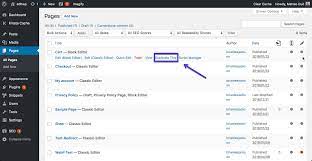
Making a duplicate of a post or page allows you to work on it without affecting the original.
We’ll show you how to quickly duplicate a WordPress page or post with all of its settings in this article.
Why should you clone or duplicate a WordPress page or post?
When you’ve been blogging for a while, you might need to quickly copy a post or page.
For example, a sales page with a lot of content that can be reused, or an older article that can be expanded into a new article.
You could now manually copy and paste the post or page’s contents into a new draft. This does not, however, copy your featured image, post settings, SEO settings, or other metadata.
Wouldn’t it be great if there was a simpler way to duplicate a post or page with all of its settings and content?
With this method, you can simply edit a post and begin working on it right away.
Let’s take a look at how to clone a WordPress post or page with a single click.
Make a duplicate of a WordPress post or page
You must first install and activate the Duplicate Post plugin. See our step-by-step guide on how to install a WordPress plugin for more information.
After activation, go to the Posts » All Posts page. Below each post title, you’ll notice two new links to clone or create a new draft.
Clicking ‘Clone’ will simply create a duplicate post without opening it in the post editor.
The ‘New Draft’ option duplicates the post and opens the duplicate version in the post editor, allowing you to begin working on it immediately.
The same options are available for pages as well.
The duplicate post plugin performs admirably. However, if you want to use it primarily to update previously published posts, there is a better way to do so.
For more information, see our guide on how to properly update live published posts in WordPress.
If you want to use it for other scenarios like website redesign, landing page copying, and so on, this is where the plugin shines.
Changing the Settings of the Duplicate Post Plugin
The duplicate post plugin works right away and by default supports posts and pages.
You can also configure the plugin to support custom post types, restrict to user roles, and select what to duplicate when creating a duplicate.
Let’s take a look at each of these options.
To configure plugin settings, navigate to the Settings » Duplicate Post page.
There are three tabs on the settings page. The first tab allows you to select what to duplicate when creating a duplicate.
Most websites should be fine with the default settings. You can, however, check the items you want to copy and uncheck the items you don’t want copied.
The next step is to navigate to the permissions tab.
The plugin allows the administrator and editor user roles to create duplicate posts by default.
It also enables the duplicate post feature for post types such as posts and pages.
If you use custom post types on your website, those post types will be displayed here. You have the option of enabling the duplicate post feature for those post types as well.
Finally, click the Display tab to specify where you want the clone post links to appear. The plugin displays them by default on the post list, edit screen, and admin bar.
Don’t forget to save your settings by clicking the Save Changes button.
That’s all there is to it; we hope this article taught you how to easily duplicate a WordPress page or post.

